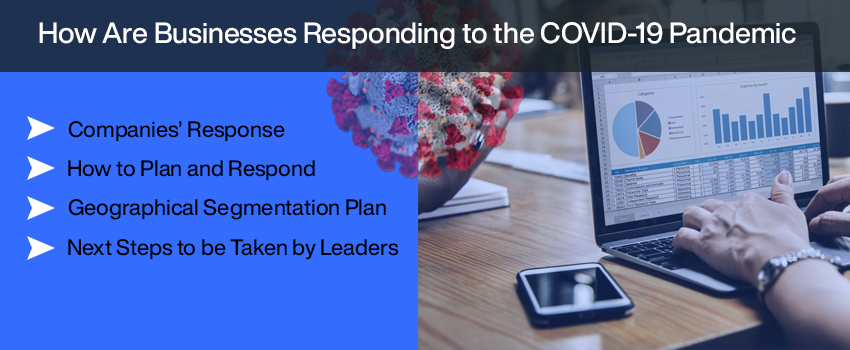How Are Businesses Responding to the COVID-19 Pandemic?
Communities and businesses worldwide are affected by COVID-19. Organizations from all over the world are coming together to find innovative ways to lessen its impact on the public via disinfecting surfaces, avoid touch and many other measures. However, there have been disruptions in the supply chain and economies due to sudden lockdown in various countries.

Organizations and cooperates all around the globe are finding different ways to tackle the pandemic. Frontline healthcare workers have been working hard to supply a sufficient amount of medicines to the people fighting coronavirus. Doctors, nurses, and community health workers are striving hard to limit the spread. Amidst COVID-19 many health workers are getting infected while providing care.
Companies worldwide are investing and providing resources and volunteer manpower to fight COVID-19. Business leaders are continuously working to evolve from this situation as companies have already faced implications. Seeing the outbreak quickly move, more than 175 countries have reported cases of COVID-19. Seeing the accelerated growth and widespread transmission, authorities have launched unprecedented public-health guidelines.
Companies’ Response
Enterprises are taking measured steps to safeguard employees by imposing travel restrictions, social distancing and suspending operations in affected regions. Work from home has been invoked by the multinational businesses. There have been some business disruptions during this global crisis.
- Greater contagion will affect the ongoing viability of operations. Companies are developing specific crisis management annexure to deal with such pandemic threats to provide an effective response to these events by coordinating with the authorities.
How to Plan and Respond
There is a major difference between business disruptions caused by pandemic events and the ones caused by natural or technological failures. The increased scale, the duration could influence the expansion and planning strategies. Organizations have incorporated existing resilience management activities to manage critical situations with a comprehensive and continuous response meeting the necessities of the employees.
- Some companies had pandemic-specific policies and procedures, whereas the ones who did not have made and implemented them for employee’s communications, commuting and leave to minimize disruptions of the enterprises.
- The impact on the workforce, customers, suppliers, and competitors living in contagion areas has had cascading impacts leading to a significant shortage of workforce.
- Coordination amongst public, government, police and health officials is required not only within one jurisdiction but within countries.
Next Steps to be Taken by Leaders
The first and foremost priority of any company during a pandemic is the well-being of the employees. Workforce often lacks in work responsibilities when the health of everyone is in peril. Companies should closely monitor the situation to continuously support and provide a safe work environment for the employees from the onset of the pandemic.
- Also, if some employees are voluntarily working they should be given recognition. Raise awareness and establish employee standards of care to support the sick staff or their family members.
- Regular two-way communication will play a pivotal role in disseminating necessary and critical information, and tests should be in place in case of a suspect.
- Alternative communication through social media channels can be used when telecommunication network capacity is blocked or strained.
- If companies provide pandemic-related training, then the employee would be more prepared to handle such situations that could alleviate the concerns.
Geographical Segmentation Plan
A pandemic impacts geographies and areas that consequently result in making those states or countries inaccessible for an extended period of time.
- Having interdependencies to such impacts will help in potential mitigation strategies for the proper functioning.
- Companies should pay closer attention to such critical activities and functions, and segment the workforce to alternate locations and sites to diversify the base, customers and service providers.
In the end
These are some of the methods that will support remote work and virtual collaboration when companies use advanced technology and have good infrastructure to limit exposure and slow down the spread of the COVID-19.


